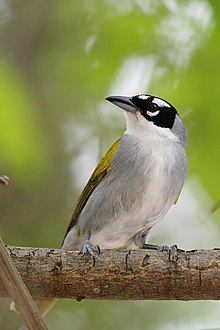Phaenicophilus
Appearance
| Phaenicophilus | |
|---|---|

| |
| Black-crowned tanager (Phaenicophilus palmarum) | |
| Scientific classification | |
| Domain: | Eukaryota |
| Kingdom: | Animalia |
| Phylum: | Chordata |
| Class: | Aves |
| Order: | Passeriformes |
| Family: | Phaenicophilidae |
| Genus: | Phaenicophilus Strickland, 1851 |
| Type species | |
| Turdus palmarum[1] Linnaeus, 1766
| |
Phaenicophilus is a genus of birds that was formerly placed in the family Thraupidae, but is now placed in the Hispaniolan tanager family Phaenicophilidae. Its members are known as palm-tanagers.
The genus Phaenicophilus was introduced by the English geologist and naturalist Hugh Edwin Strickland in 1851.[2] The type species was subsequently designated as the black-crowned palm-tanager.[3]
The genus contains the following species:[4]
| Image | Scientific name | Common Name | Distribution |
|---|---|---|---|
 |
Phaenicophilus palmarum | Black-crowned palm-tanager | Haiti and the Dominican Republic |
 |
Phaenicophilus poliocephalus | Grey-crowned palm-tanager | Haiti and the Dominican Republic |
References
[edit]- ^ "Phaeenacophilidae". aviansystematics.org. The Trust for Avian Systematics. Retrieved 2023-07-16.
- ^ Strickland, Hugh Edwin (1851). "Ornithological notes". Contributions to Ornithology. 3–4: 103–104 [104].
- ^ Paynter, Raymond A. Jr, ed. (1970). Check-list of Birds of the World. Vol. 13. Cambridge, Massachusetts: Museum of Comparative Zoology. p. 277.
- ^ Gill, Frank; Donsker, David; Rasmussen, Pamela, eds. (December 2023). "Caribbean "tanagers", Wrenthrush, Yellow-breasted Chat". IOC World Bird List Version 14.1. International Ornithologists' Union. Retrieved 22 January 2024.
